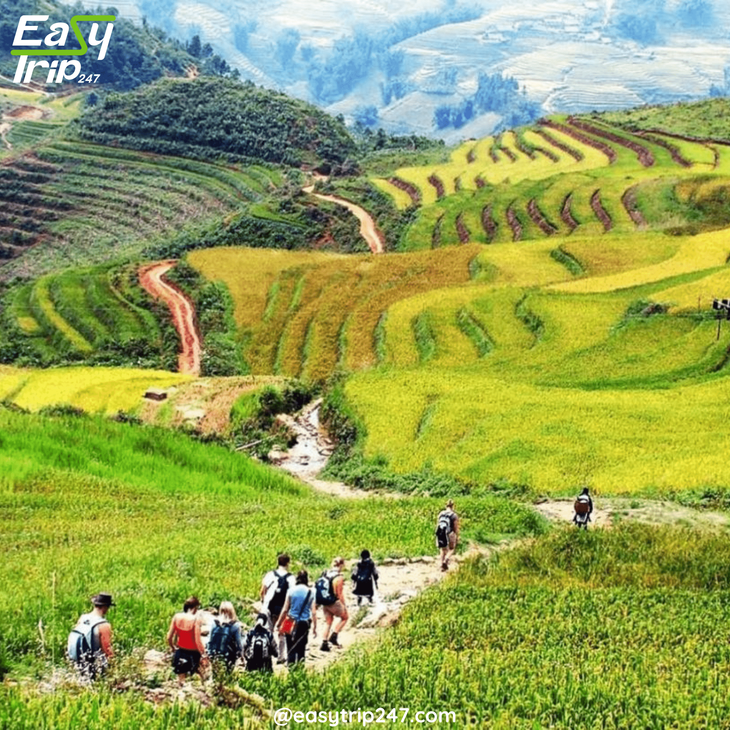Ideal Months for Trekking in Sapa, Vietnam
On
23/06/2025Reading time:
1 min
Summary:
Sapa, a captivating region in northern Vietnam, is renowned for its breathtaking landscapes, including terraced rice fields, misty mountains, and remote villages. It's no surprise that this picturesque area has become a favorite destination for trekking enthusiasts from around the world.

Sapa's climate is influenced by its high-altitude location, which creates distinct seasonal changes. The region experiences four main seasons: spring, summer, autumn, and winter. Each of these seasons offers different trekking conditions, making it possible to find the ideal time to visit Vietnam for trekking at almost any time of the year. This guide will break down the best months to visit Sapa and help you plan your trekking adventure, whether you're looking to witness the famous rice terraces or enjoy the cool mountain air.
Spring (March to May): Lush Greenery and Mild Weather
For trekkers seeking cool weather, blooming flowers, and a vibrant landscape, spring is often considered the ideal time to visit Vietnam for trekking in Sapa. From March to May, the temperatures in Sapa are mild, with daytime highs ranging from 15°C to 25°C, and the nights remaining cool but not too cold. This makes spring a comfortable time for hiking through the mountainous terrain and exploring the beautiful villages that dot the landscape.
Spring in Sapa is a time when nature is in full bloom, and the region comes alive with colors. The peach blossoms and mustard flowers paint the fields in shades of pink and yellow, providing a stunning backdrop for trekkers. The rice terraces, freshly planted after the winter, begin to turn a vibrant green, creating a patchwork of lush fields stretching across the valleys and hills. If you’re a photographer or nature lover, this is one of the ideal times to visit Vietnam for trekking, as you’ll be treated to some of the most scenic views that Sapa has to offer.
In addition to the mild temperatures and picturesque scenery, spring is also a great time to experience local festivals and traditions. The local ethnic minorities, such as the H’mong, Tay, and Zao people, celebrate their New Year and other cultural events during this time, adding an extra layer of authenticity to your trekking experience. Spring is also less crowded than the peak seasons of summer and autumn, making it a peaceful time to enjoy the beauty and serenity of Sapa’s natural wonders. Whether you’re exploring the Muong Hoa Valley or trekking to Fansipan, Vietnam’s highest peak, spring offers the ideal time to visit Vietnam for those looking for a combination of stunning landscapes and cultural immersion.
Summer (June to August): Vibrant Greenery and Solitude
While summer in Sapa can be wet, it still has its appeal for those seeking solitude and an opportunity to witness the region at its most lush and green. From June to August, Sapa experiences its rainy season, with frequent showers and high humidity. While this may not be the ideal time to visit Vietnam for trekkers who prefer dry conditions, the landscape transforms into an enchanting, verdant paradise during this period. The rice terraces are a brilliant green, and the valleys become thick with vegetation, creating a breathtaking sight for those who venture into the hills despite the rain.
One of the advantages of trekking in Sapa during the summer months is the relative lack of tourists. While the weather can be unpredictable, summer offers an opportunity to experience Sapa's natural beauty in peace and solitude. You can trek along the less-traveled paths without the crowds that flock to the area during the peak seasons. The landscape during this time is incredibly lush, and the misty atmosphere adds a sense of mystery and tranquility to your journey.
If you're an experienced trekker who enjoys a challenge and is prepared for wet conditions, summer may still be the ideal time to visit Vietnam. However, be sure to pack proper rain gear, as heavy downpours are common, and certain trails may become slippery or muddy. Despite the rain, summer is a wonderful time for those looking to experience the quieter side of Sapa and connect with nature without the distractions of peak-season tourists.
Autumn (September to November): The Golden Harvest Season
For many trekkers, autumn is the ideal time to visit Vietnam for trekking in Sapa, as it is the season when the rice terraces reach their most iconic state. From September to November, the region’s rice fields turn golden, signaling the harvest season. This transformation makes autumn one of the most picturesque times to explore Sapa, with golden rice paddies stretching across the valleys and hills, set against a backdrop of towering mountains and clear skies. The vibrant colors of the rice terraces, combined with the crisp air and pleasant temperatures, create a trekking experience that is nothing short of magical.
Autumn in Sapa offers cool weather with temperatures ranging from 18°C to 22°C, which is ideal for hiking and exploring the region’s numerous trekking routes. The skies are usually clear, and the air is fresh, making it a great time for panoramic views of the surrounding landscape. The harvest season also brings a lively atmosphere to Sapa, as local ethnic minorities celebrate with cultural rituals, festivals, and traditional ceremonies. If you're looking for an opportunity to experience Sapa’s rich culture while trekking, autumn is definitely the ideal time to visit Vietnam.
Another reason autumn is a top choice for trekking in Sapa is the dry weather. The rain has subsided, making the trails accessible and free from the mud and slippery conditions of the summer months. Whether you’re hiking to the top of Fansipan or exploring the picturesque villages like Lao Chai and Ta Van, autumn’s perfect weather and stunning scenery will ensure an unforgettable trekking experience.
Winter (December to February): Solitude and Snow-Capped Peaks
Winter in Sapa, from December to February, offers a completely different experience compared to the other seasons, and for some, it may be the ideal time to visit Vietnam for trekking. During this period, temperatures drop significantly, ranging from 5°C to 15°C, and the weather can be quite cold, particularly in the higher altitudes. Snow is also a possibility, especially in the mountain peaks, which creates a winter wonderland that is rarely seen in other parts of Vietnam. While the lower valleys may still have mild weather, the higher elevations of Sapa are often blanketed in frost or snow, providing trekkers with a truly unique landscape.
Winter is the least crowded time to visit Sapa, offering a peaceful and solitary trekking experience. The trails are quiet, and you’ll have the opportunity to enjoy the region’s beauty in tranquility. However, trekking during this time does come with challenges. The cold weather and potential snowfall can make the trails more difficult, and trekkers need to be well-prepared with warm clothing, waterproof gear, and sturdy boots.
Despite the colder conditions, winter trekking in Sapa is a rewarding experience for those who seek solitude and the chance to see the region’s stunning snow-covered landscapes. It’s the ideal time to visit Vietnam for those who enjoy rugged conditions and the opportunity to witness a side of Sapa that is completely different from the lush greenery of spring and summer or the golden harvest of autumn.
Conclusion: Choosing the Ideal Time to Visit Vietnam for Trekking in Sapa
The ideal time to visit Vietnam for trekking in Sapa depends largely on what you’re hoping to experience. Each season brings something special, and your personal preferences—whether you’re seeking vibrant rice terraces, cooler temperatures, or peaceful solitude—will help guide your decision. For those looking for lush greenery and comfortable temperatures, spring (March to May) is a great choice, while summer (June to August) offers a quieter trekking experience amidst the vibrant green landscape. Autumn (September to November) is the most popular time to visit, with golden rice fields and perfect trekking weather, while winter (December to February) provides a serene escape with the possibility of snow.
Ultimately, Sapa is a year-round destination for trekkers, and with proper planning and preparation, you can enjoy the region’s natural beauty no matter when you decide to visit. By considering the ideal time to visit Vietnam for trekking in Sapa, you can ensure that your journey is filled with unforgettable moments and spectacular views.
Design Your Tour Today And Get A Quote. Contact Us Here: +84.975.504.825
Source: Easytrip247 Team compiled.
